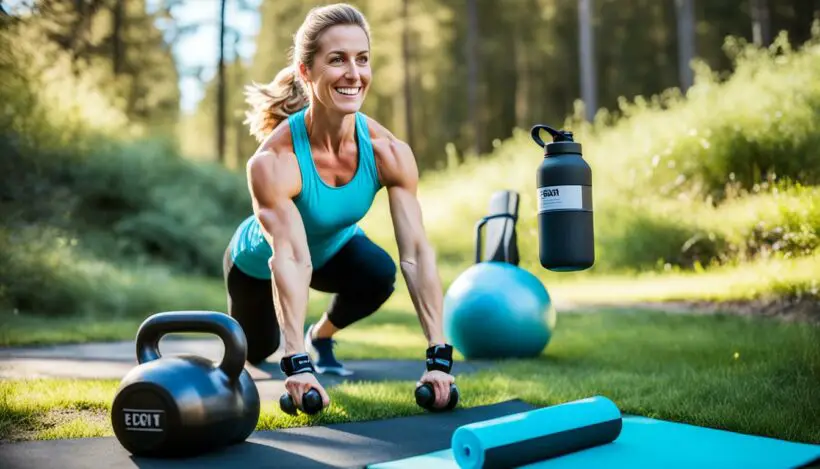Are you looking to create a balanced workout regimen that targets every aspect of your fitness? Look no further! In this article, we will guide you through the process of building a holistic exercise plan that covers all the bases.
A comprehensive fitness program is key to achieving your goals and maintaining overall health. It should encompass various activities that challenge your body and engage different muscle groups. By incorporating diverse fitness activities into your routine, you can keep things interesting and maximize your results.
From aerobic fitness to strength training, core exercises to balance training, and flexibility to stretching, we will explore each component of a well-rounded fitness routine. Whether you are a beginner or an experienced fitness enthusiast, this article will provide you with valuable insights and tips to create an all-encompassing training routine that suits your needs.
Get ready to take your workout to the next level with our expert advice and practical guidance. Let’s dive in and discover how you can design a total body workout schedule that guarantees results. Embrace the power of diverse fitness activities and embark on a journey towards a complete exercise regimen.
The Importance of Aerobic Fitness
Aerobic fitness is a fundamental component of any well-rounded fitness routine. It involves engaging in various activities that elevate your heart rate and increase your breathing. These activities, commonly referred to as cardio or endurance exercises, are essential for improving cardiovascular health, boosting oxygenation throughout the body, and enhancing your overall physical performance.
There are numerous aerobic activities to choose from, allowing you to find the ones that suit your preferences and fitness level. Walking, jogging, biking, swimming, dancing, and hiking are just a few examples of aerobic exercises. By incorporating these activities into your routine, you can reap the benefits of improved heart health, increased lung capacity, and a more efficient circulatory system.
Engaging in regular aerobic activity has numerous advantages. First and foremost, it strengthens your cardiovascular system by promoting better heart function and increasing blood flow. As a result, your body becomes better equipped to supply oxygen and nutrients to your muscles, improving their endurance and performance during physical tasks.
This increased oxygenation not only enhances your physical abilities but also has a positive impact on your overall well-being. Regular aerobic exercise can help reduce the risk of chronic diseases such as heart disease, stroke, and type 2 diabetes. It also aids in managing weight, improving mood, and reducing stress levels.
Benefits of Aerobic Fitness:
- Improved cardiovascular health
- Increased oxygenation throughout the body
- Enhanced endurance and stamina
- Reduced risk of chronic diseases
- Weight management support
- Improved mood and reduced stress levels
Including aerobic fitness activities in your workout routine is crucial for maintaining a healthy and active lifestyle. Not only will it boost your overall physical fitness, but it will also make everyday tasks easier to perform. So lace up your sneakers, dive into the pool, or hop on your bike to get your heart pumping and experience the benefits of aerobic fitness.
The Benefits of Strength Training
Strength training is a crucial component of a well-rounded fitness routine, offering numerous benefits for your overall health and well-being. By engaging in regular strength training exercises, you can improve muscular fitness, increase bone strength, manage your weight, and enhance your ability to perform everyday activities.
When you participate in strength training, whether it’s using resistance machines, free weights, or bodyweight exercises, you challenge your muscles and stimulate growth. This results in increased muscle strength, endurance, and overall muscular fitness.
One of the key advantages of strength training is its positive effect on bone strength. The stress placed on the bones during resistance exercises stimulates the production of new bone tissue, ultimately improving bone density and reducing the risk of osteoporosis.
In addition to building muscle and bone strength, strength training plays a significant role in weight management. By increasing your muscle mass, you boost your metabolism and burn more calories even at rest. This can help support weight loss or maintenance goals.
Moreover, strength training enhances your ability to perform everyday activities with ease. By strengthening the major muscle groups in your body, such as your legs, arms, back, and core, you improve your overall functional fitness. This means that tasks like lifting heavy objects, climbing stairs, or carrying groceries become easier and less strenuous.
Incorporating strength training exercises into your fitness routine can be highly beneficial. Aim to target all major muscle groups at least twice a week to ensure you are providing comprehensive and well-rounded training for your body.
Now let’s move on to the next section to explore the importance of core exercises for stability and injury prevention.
Core Exercises for Stability and Injury Prevention
Strengthening your core is essential for stability, injury prevention, and overall fitness. The core muscles, including the abdominal muscles, back muscles, and pelvis, provide a solid foundation for your body’s movements. By incorporating specific core exercises into your fitness routine, you can improve your balance, posture, and reduce the risk of falls and back pain.
Some effective core exercises to include in your workout regimen are:
- Planks: Start in a push-up position with your forearms on the ground and your body straight. Hold this position for as long as you can while maintaining proper form. Planks engage multiple core muscles simultaneously.
- Sit-ups: Lie on your back with your knees bent, feet flat on the ground, and hands behind your head. Engage your core to lift your upper body off the ground and towards your knees. Slowly lower back down and repeat.
- Bridges: Lie on your back with your knees bent and feet flat on the ground. Lift your hips off the ground, engaging your glutes and core muscles. Hold for a few seconds and then lower back down. Repeat for the desired number of repetitions.
- Fitness Ball Exercises: Utilize a stability ball to perform various core exercises such as sit-ups, Russian twists, and back extensions. The unstable surface of the ball forces your core muscles to work harder to maintain balance.
A strong core is not only crucial for injury prevention but also enhances performance in other fitness activities. By adding core exercises to your routine, you can improve your stability, maintain proper posture, and enhance your overall fitness level.
https://www.youtube.com/watch?v=H1sqZRiNQwg
The Importance of Balance Training
Balance training is often overlooked in fitness routines, but it plays a crucial role in maintaining stability, developing proprioception (awareness of the body in space), and strengthening stabilizer muscles. Incorporating balance exercises can help prevent falls, improve reaction time, and enhance brain function.
When we think of balance, we often picture standing on one leg, but balance training can involve a wide range of exercises. Simple one-leg balance holds can be a great starting point for beginners, while more advanced practitioners can challenge themselves with exercises using a balance pad or other unstable surfaces.
The Benefits of Balance Training
- Stability: By improving balance, you enhance your ability to stay upright and maintain control during various movements and activities.
- Proprioception: Balance training helps develop your body’s proprioceptive sense, allowing you to better understand where your body is in space without relying solely on visual cues.
- Stabilizer Muscles: Balance exercises engage stabilizer muscles, which are responsible for supporting and maintaining proper joint alignment. Strengthening these muscles helps prevent injuries and supports overall joint health.
- Fall Prevention: By improving balance and coordination, you can reduce the risk of falls, especially in older adults who may be more prone to balance-related accidents.
- Brain Function: Balance training challenges the brain by requiring it to process sensory information and make adjustments for maintaining equilibrium. This engagement can enhance cognitive function and contribute to overall brain health.
To incorporate balance training into your fitness routine, start with simple exercises and gradually progress to more challenging ones. Focus on maintaining proper form and control throughout each movement. Remember to consult with a fitness professional to ensure that you’re performing exercises correctly and safely.
The Benefits of Flexibility and Stretching
Flexibility and stretching play a crucial role in maintaining overall fitness and well-being. By incorporating regular stretching exercises into your fitness routine, you can improve joint mobility, enhance muscle control, correct posture, and find relief from muscle tension and stress.
One of the main benefits of flexibility exercises is increased joint mobility. Stretching helps to loosen tight muscles and tendons, allowing your joints to move more freely. This increased range of motion can improve your performance in physical activities and reduce the risk of injuries.
Stretching also plays a role in muscle control. When your muscles are flexible, they can contract and relax more efficiently. This improved muscle control can enhance your athletic performance and make your everyday movements smoother and more coordinated.
Improving posture
A sedentary lifestyle and prolonged periods of sitting can contribute to poor posture. Regular stretching can help lengthen tight muscles that pull your body out of alignment and restore proper posture. By improving your posture, you can alleviate muscle imbalances, reduce the risk of injury, and even boost your self-confidence.
Moreover, stretching has a direct effect on relieving muscle tension and stress. When you stretch, you promote blood flow to the muscles, which can help relax them and reduce muscle soreness. Stretching also helps activate the parasympathetic nervous system, promoting a relaxation response and aiding in stress relief.
It’s important to note that stretching is most effective when performed after exercise, when your muscles are warm and more pliable. Incorporate a variety of stretching exercises into your post-workout routine to target different muscle groups. Remember to hold each stretch for at least 30 seconds, breathing deeply and relaxing into each position.
So, make flexibility and stretching an integral part of your fitness routine for improved joint mobility, enhanced muscle control, better posture, and relief from muscle tension and stress. With consistent stretching, you’ll not only improve your physical well-being but also experience the benefits of a relaxed mind and body.
Adding High-Intensity Interval Training (HIIT)
Looking to take your fitness routine to the next level? Consider incorporating high-intensity interval training (HIIT) into your workouts. This popular training method involves alternating bursts of intense activity with short recovery periods, delivering a powerful cardiovascular workout while maximizing calorie burning.
HIIT is known for its ability to improve cardiovascular fitness and endurance. By pushing your body to perform at a high intensity during short bursts of activity, you challenge your cardiovascular system and increase its efficiency. This translates to better overall endurance and the ability to sustain high-intensity workouts for longer periods.
Calorie burning is another key benefit of HIIT. The intense bursts of activity require a high level of effort, which not only pushes your body to burn calories during the workout but also continues to burn calories even after your session is over. This is known as the “afterburn effect” or excess post-exercise oxygen consumption (EPOC), where your body continues to burn calories at an elevated rate during the recovery period.
When it comes to HIIT exercises, the options are endless. You can choose activities such as sprinting, cycling, jumping jacks, or bodyweight exercises like burpees and mountain climbers. The key is to give your maximum effort during the intense periods and then allow yourself to recover before the next burst of activity.
Adding HIIT to your well-rounded fitness routine can bring variety and a new level of intensity to your workouts. It’s a time-efficient way to improve cardiovascular fitness, build endurance, and torch calories. Whether you’re a beginner or a seasoned fitness enthusiast, HIIT can be adapted to suit your fitness level and goals.
Remember, as with any new workout program, it’s important to consult with a healthcare professional or a certified trainer before starting HIIT. They can help you develop a program that is appropriate for your fitness level and ensure proper form to minimize the risk of injury.
So why wait? Give HIIT a try and experience the benefits of high-intensity interval training firsthand.
Benefits of High-Intensity Interval Training:
- Improved cardiovascular fitness and endurance
- Increased calorie burning during and after workouts
- Time-efficient workouts
- Variety and diversity in training
- Adaptable to different fitness levels
Creating a Diverse Workout Schedule
Incorporating diverse fitness activities into your workout schedule is key to maintaining motivation and achieving a well-rounded fitness routine. By introducing a variety of exercises, you can keep things interesting and prevent boredom from setting in. Here are some ideas to add diversity to your workout regimen:
1. Different Forms of Aerobic Exercise
- Go for a run or walk outdoors
- Take a cycling or spin class
- Try swimming or water aerobics
- Dance to your favorite songs or take a Zumba class
2. Strength Training Exercises
- Use free weights or resistance machines at the gym
- Try bodyweight exercises like push-ups, squats, and lunges
- Take a strength training class
3. Core Exercises
- Include planks, sit-ups, and bridges in your routine
- Try using a fitness ball for additional core activation
4. Balance Training
- Practice one-leg balance holds
- Try balancing on a balance pad or cushion
5. Flexibility Exercises
- Include static and dynamic stretches for all major muscle groups
- Try yoga or Pilates classes for added flexibility benefits
6. High-Intensity Interval Training (HIIT)
- Combine short bursts of intense activity with recovery periods
- Include exercises like sprints, burpees, or jump squats
By incorporating a variety of these activities into your workout schedule, you can keep your fitness routine interesting and challenging. Remember, motivation thrives on variety and novelty, so embrace the opportunity to try new activities and find what works best for you.
Customizing Your Fitness Routine
A well-rounded fitness routine is not a one-size-fits-all approach. It should be customized to align with your personal goals, preferences, and fitness level. The key is to seek guidance from a knowledgeable personal trainer who can help create a program tailored to your specific needs.
The trainer will take into account your goals, whether it’s weight loss, muscle gain, or improved cardiovascular fitness. They will also consider your preferences, such as the types of exercises you enjoy and the time you can dedicate to your workouts.
Additionally, your current fitness level will be taken into consideration. The trainer will assess your strength, flexibility, and endurance to determine the appropriate starting point for your customized routine.
With guidance from a trainer, you can confidently navigate through the vast array of exercises and equipment available to create an effective fitness plan. They can recommend exercises that target your individual goals and provide modifications based on your fitness level.
The trainer will also help you determine the appropriate intensity for each exercise, ensuring that you are challenging yourself without risking injury. They will ensure you are using proper form and technique to maximize the benefits of each movement.
Furthermore, a trainer can monitor your progress and make necessary adjustments to your routine as you continue to improve. They can provide ongoing support and motivation, helping you stay accountable and committed to your fitness journey.
Remember, a customized fitness routine is designed to fit you and your unique needs. By seeking guidance from a qualified trainer, you can create a program that will maximize your results and keep you motivated on your path toward a healthier, fitter lifestyle.
Progression and Adaptation in Fitness Training
Progression and adaptation are fundamental aspects of effective fitness training. To continue improving and avoid hitting a plateau, it’s important to gradually increase the intensity or difficulty of your exercises over time.
This can be achieved by adding resistance, increasing the weight lifted, or performing more challenging variations of the exercises. For example, if you’ve been doing squats with body weight, you can progress to using dumbbells or a barbell.
By pushing your limits and stepping outside of your comfort zone, you’ll experience greater gains in strength, endurance, and overall fitness. Embrace the opportunity to challenge yourself and strive for continual improvement.
However, it’s equally important to strike a balance between challenging workouts and proper rest and recovery periods. Overtraining can lead to fatigue, decreased performance, and even injuries. Listen to your body and prioritize adequate rest days to allow your muscles and joints to recover.
Remember, fitness is a journey, and progression should be gradual to ensure sustainability and long-term success. Celebrate your achievements along the way and stay motivated to continue challenging yourself and adapting your workouts.
Benefits of progression and adaptation in fitness training:
- Prevents plateauing and ensures continued improvement
- Increases strength, endurance, and overall fitness
- Enhances muscle growth and definition
- Boosts metabolism and calorie burn
- Improves cardiovascular health and function
- Enhances athletic performance
- Builds mental resilience and self-confidence
Keep in mind that everyone’s fitness journey is unique, so it’s important to listen to your body and work with a certified fitness professional to design a training program tailored to your specific goals and needs.

Tracking and Evaluating Your Fitness Progress
Tracking your progress and evaluating the results are essential steps in achieving your fitness goals. It helps you stay motivated and make informed decisions about your fitness routine. By keeping a record of your measurements, performance improvements, and other relevant data, you can track your progress over time and make necessary adjustments to ensure continuous improvements.
One effective way to track your progress is by regularly measuring key indicators such as weight, body measurements, and body fat percentage. These measurements provide objective data that can reflect changes in your body composition and overall fitness level. Additionally, you can also track your performance improvements in terms of strength, endurance, speed, or flexibility. Keep a log of the exercises you do, the weights you lift, the distances you run, or any other relevant data that showcases your progress.
Evaluating your results involves analyzing the data you’ve collected and identifying areas of improvement. It’s important to set realistic and achievable fitness goals, and then assess whether you’re making progress towards those goals. Look for patterns and trends in your data to see if your efforts are paying off. For example, if your goal is to increase strength, track the weights you’re lifting and see if you’re able to progressively increase them over time. If your goal is to improve cardiovascular endurance, monitor your heart rate during aerobic activities and see if it becomes more efficient.
Based on your evaluation, you can make necessary adjustments to your fitness routine. If you’re not seeing the desired progress in certain areas, you may need to modify your approach. This could involve changing the types of exercises you’re doing, increasing the intensity or duration of your workouts, or seeking guidance from a fitness professional to develop a more effective plan.
Remember, tracking progress and evaluating results are ongoing processes. As you continue your fitness journey, regularly assess your data and adjust your routine accordingly. Celebrate your achievements along the way and use your progress as motivation to keep pushing forward.
- Track your measurements and performance improvements
- Regularly measure key indicators such as weight and body fat percentage
- Evaluate your results to identify areas of improvement
- Set realistic and achievable fitness goals
- Make necessary adjustments to your fitness routine based on evaluation
Conclusion
In conclusion, a well-rounded fitness routine is essential for achieving optimal health and fitness. A balanced workout regimen should include aerobic fitness, strength training, core exercises, balance training, and flexibility and stretching. By incorporating these elements into your comprehensive fitness program, you can maximize the benefits and achieve long-term success.
It is crucial to customize your fitness routine based on your personal goals and preferences. Whether you aim to improve cardiovascular endurance, build strength, enhance balance, or increase flexibility, tailoring your workouts to your specific needs is key. Seek guidance from a qualified trainer who can provide expert advice and help you create a program that suits your fitness level and targets your desired outcomes.
Tracking your progress and making necessary adaptations are also important for continued growth and improvement. Regularly evaluate your fitness goals, measure your performance improvements, and adjust your routine accordingly. Embrace variety by incorporating diverse fitness activities into your workouts to keep yourself motivated and prevent monotony. By challenging yourself and staying committed to a well-rounded fitness routine, you can create a holistic and comprehensive program that will lead you to a healthier and fitter lifestyle.






